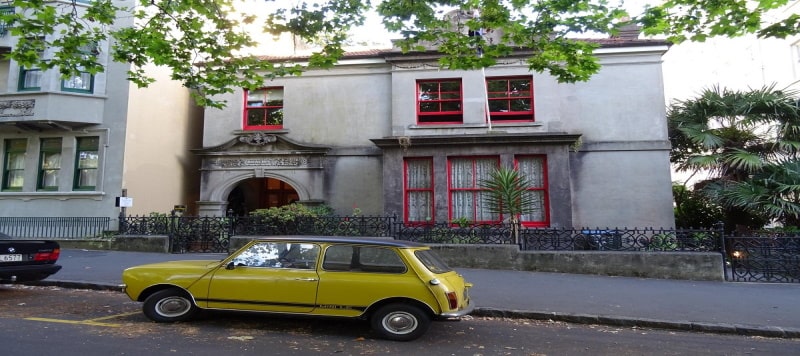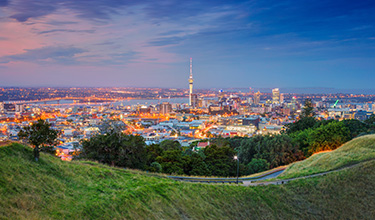
You can search for holidays
New Zealand Holidays
New Zealand comprises two unique islands in the Pacific, with landscapes so breath-taking and diverse that you’ll feel like you have gone back to the beginning of time. That's certainly what the makers of the film ‘Lord of the Rings’ must have felt, selecting New Zealand to represent Middle Earth.
New Zealand’s North Island won't disappoint. Among the island’s impressive landscapes is the Bay of Islands, with turquoise waters and 150 islands to explore, full of majestic orcas. Then there’s the charming cities of North Island, including the capital of New Zealand - Wellington and the multi-cultural city of Auckland. The South Island New Zealand, most famously known for skiing sites in the mountains surrounding Queenstown New Zealand, is where tourists flock not just for sporting adventures but simply to gaze at mountainous landscapes. The Southern Alps of New Zealand’s South Island are picturesque and perfectly snow-capped.
Map of New Zealand

The Parnell Hotel & Conference Centre
10/20 Gladstone Road, Parnell, Auckland 1052, New Zealand

Hotel De Brett
2 High St, Auckland, 1010, New Zealand

Braemar On Parliament Street
7 Parliament Street, Auckland CBD, Auckland 1010, New Zealand
Top Destinations In New Zealand

Auckland
Auckland New Zealand in North Island is the country’s largest city, surrounded by beautiful coastlines and home to unspoiled landscapes, from parks and botanic gardens to nature reserves and volcanoes. The city is not only a haven for nature lovers, but also for adrenaline junkies with a wide range of adventure activities to embark on including hiking, canyoning, bungee jumping, mountain biking, sea kayaking, and helicopter rides. Auckland also boasts some of the country’s top restaurants serving delicious food and the famous New Zealand sauvignon blanc wine.
Helpful Information About New Zealand
New Zealand Currency: You’ll be spending New Zealand dollars
New Zealand Language: English, Maori, and New Zealand Sign Language
Local Time: 12 hours ahead of GMT.
Flight time from the UK: New Zealand is one of the furthest countries from the UK. You can fly here from several UK airports, with most routes operating to Auckland with an average total travel time of around 24 hours (there is no direct flight to New Zealand).
Tourist Information: Visit the official New Zealand tourist information site for lots of helpful information regarding upcoming events, where to go, what to do, and how to get around.
Health/Travel Restrictions: To travel to New Zealand, British citizens need a valid passport, and although a travel visa is not required, a New Zealand Electronic Travel Authority (NZeTA) will be required. For up to date travel advice and health recommendations visit the government’s travel advice for New Zealand.
Other FAQs:
Q: What is the best time to visit New Zealand?
A: This depends on where is being visited in New Zealand, but generally we’d recommend visiting during the summer between December and March which sees more sunshine hours and warmer temperatures. March is a particularly ideal month to visit when the crowds start to lessen.
Q: How big is New Zealand?
A: New Zealand is a long country, extending more than 1600km, and its widest point is around 400km, with a total land area of approx. 268,000 square km.
Q: Is New Zealand safe?
A: New Zealand has a low crime rate, however street crimes do still occur in the country’s major cities, including theft. It’s advised to not leave possessions unattended unless they are locked in a hotel safe.
Q: Can you ski in New Zealand?
A: Yes! New Zealand is an excellent skiing location and its ski season runs between June and October/November. Queenstown and Mt Ruapehu are popular ski locations.
Top Things to do in New Zealand
Visit Auckland and look forward to a myriad of epic travel experiences. Take a scenic stroll through Auckland Park in Bishop, spend the day encountering wildlife at Auckland Zoo, set your sights on the city at the top of the soaring Sky Tower, travel across Auckland Harbour Bridge, and step back in time to historic New Zealand at the Auckland War Memorial Museum. From Auckland, take a short ferry journey to Waiheke Island for even more amazing leisure opportunities, from white sand beaches to olive groves, vineyards, and colourful art galleries.
Weather in New Zealand
New Zealand has varied climates which includes a subtropical climate in its far north, and a cooler temperature climate in its far south, plus alpine weather in its mountainous regions. For the majority of the country there is around 600-1600mm of annual rainfall, with a dry season during the summer (December-March) for the country’s northern and central regions, and drier weather during the winter (June-August) in the southern part of New Zealand.
Looking for other holidays?
Copyright ©2025 Brightsun Travel. All rights reserved.


